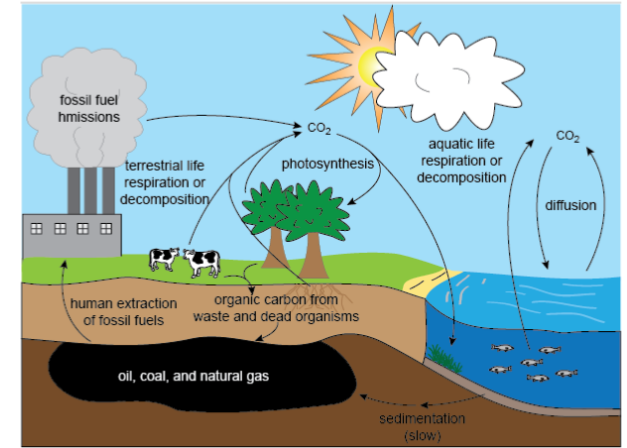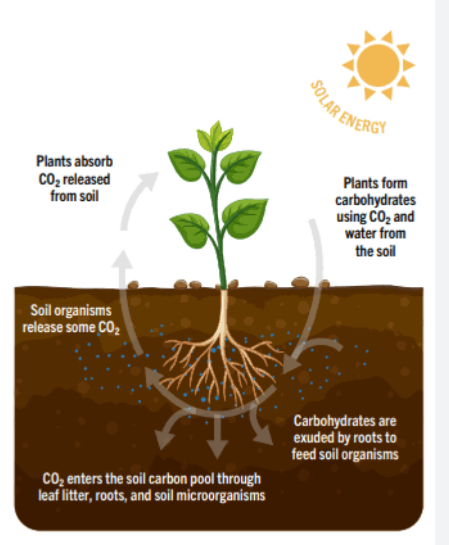
The global reservoirs of carbon include: the atmosphere, the ocean, terrestrial plant biomass, and soil. Carbon is found within these reservoirs and exchanged of the carbon occur between them. The balance of carbon between these reservoirs is important for life. For example, if there were no carbon dioxide in the atmosphere, photosynthetic organisms like plants would have no source of carbon and die out. This will ultimately affect animals. In the long term, the exchange of carbon between the different reservoirs maintain a balanced in the global amount of carbon .
Carbon is a chemical element which has the symbol C and atomic number 6. Carbon atoms can bond together to form another substance. The bonding of carbon to form a new substance is called allotropes of carbon. Some allotropes of carbon include diamond, graphite, and amorphous carbon. Graphite is one of the softest known substances and diamond is the hardest substance.
When atmospheric carbon changes, it result into changes in global temperature. Thus, causing global warming.
CARBON AND WHERE FOUND
1. ATMOSPHERIC AND WATER BODY CARBON: Atmospheric carbon can occur as carbon dioxide (CO2), or methane (CH4). CO2 is used up during respiration by terrestrial and aquatic photosynthetic organisms. When it dissolves in water bodies, it forms carbonic acid.
The amount of carbon stored in water bodies is greater than the amount in the atmosphere. Therefore, water bodies like ocean are the largest reservoir of carbon. To maintain global carbon equilibrium, an exchange of carbon do occur between the water bodies and the atmosphere. This means that changes to atmospheric carbon levels can be buffered by the water bodies: it will release CO2 if atmospheric levels drop, or dissolve CO2 from the atmosphere if levels increase.
2. SOIL CARBON: In soil, diverse biological activities take place. Several organisms such as Bacteria, archaea, fungi, protozoa, nematodes and many macroscopic species carry out the activities. They assist in production of resource like decomposition of organic matter to make nutrients available to plants, fixation of nitrogen and energy exchange, in which carbon plays a key role. Carbon is made available to the soil by photosynthetic plants. Plants can release carbon into the soil through their roots, which is known as exudation, or by decomposition when part of the plant or the whole plant dies.
Soil organism have ability to take up organic molecules which is made up of carbon. Organisms uses the carbon for the following :
a. ENERGY : Organisms break down carbon molecules to release energy required for cellular processes. For example, glycolysis.
b. PRODUCTION : Carbon molecules consumed are restructured to form useful biomolecules that supply energy required by the organism to thrive and grow.
CARBON SEQUESTRATION
Carbon dioxide is an atmospheric gas that has ability to trap heat. This gas can be produced through natural means and by human activities. Such human activities include burning coal, natural gas and oil to produce energy, cutting down forests (deforestation). Trees help to regulate the climate by absorbing CO2 from the atmosphere. While natural means ( Biological) include respiration by man, during photosynthesis by plants, outgassing from the ocean, decomposing vegetation and other biomass, venting volcanoes, naturally occurring wildfires, and even belches from ruminant animals.
The build-up of carbon dioxide and other ‘greenhouse gases’ in the atmosphere can trap heat and contribute to climate change. Therefore, there is need to Reduce the amount of this atmospheric gas and store them elsewhere for usage. This is achieved through carbon sequestration.
Carbon sequestration can be defined as the capture and secure storage of carbon that would otherwise be emitted to, or remain, in the atmosphere.
The aim of carbon sequestration is reducing or avoiding greenhouse gas (GHG) emissions. Sequestration as a function seeks to reduce net GHG emissions through the long-term storage of CO2, achieving carbon neutrality in the case of fossil carbon storage or negative emissions in the case of biogenic carbon. Storing CO2 is increasingly important because it heat up the earth causing climate change.
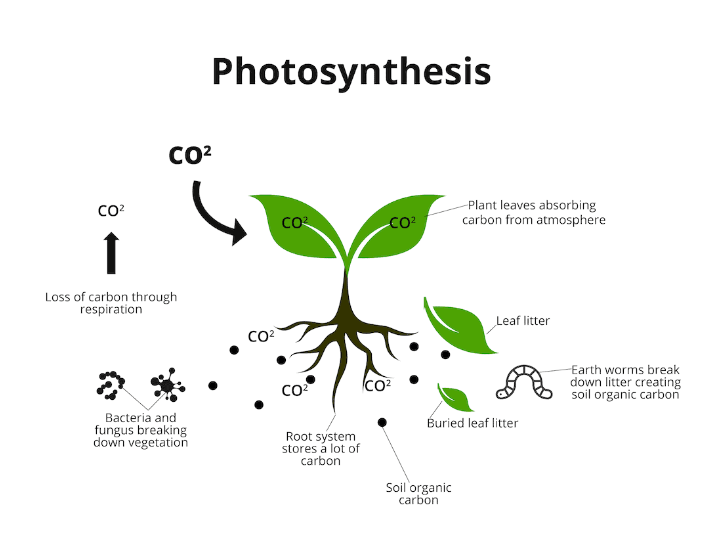
An example of how Carbon sequestration occur can be found in photosynthetic plants. As plants photosynthesize to produce their food, they remove carbon dioxide from the atmosphere and create the oxygen man needs to breathe. When the plant parts fall to the ground or the whole plant die and decompose, the carbon in its tissue is released into the soil and get stored their. Through this chemical process, carbon is sequestered in the soil.
FORMS OR TYPES OF CARBON SEQUESTRATION
Carbon sequestration can happen in three basic forms: biologically, Geological and Technological Carbon Sequestration forms.
1. BIOLOGICAL CARBON SEQUESTRATION
Biological carbon sequestration happens when CO2 is stored naturally. This includes what are known as ‘carbon sinks’, such as forests, grasslands, soil, oceans and other bodies of water. This is also known as an ‘indirect’ or passive form of sequestration.
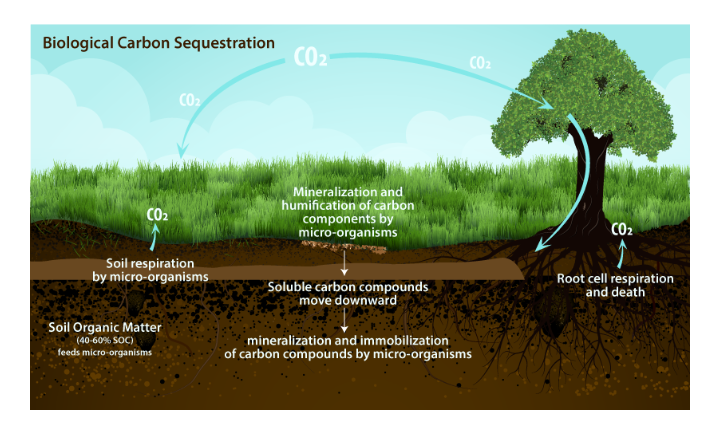
During the process of photosynthesis, some carbon are stored in plants, especially in woody plants and grasses. CO2 is removes from the atmosphere and transforms into living plant tissues. When the plant die and decompose, the carbon is released into the soil and stored.
In the oceans, CO2 is stored as dissolved gas in the water and carbonate sediments on the seafloor.
FORESTS
Forests and woodlands are considered one of the best forms of natural carbon sequestration. Forests plants which include trees (both living and dead), root systems, aboveground parts, undergrowth, the forest floor, litters and soils, absorb carbon dioxide from the atmopshere and store it in different repositories, called carbon pools, Live trees have the highest carbon density, followed by soils and the forest floor. During photosynthesis, CO2 produced binds to plants, releasing oxygen as a purifying emission. Thus, making the forests the highest store of carbon. Therefore, there is need to protect this natural environment inorder to ensure carbon sinks for effective capture of CO2 .
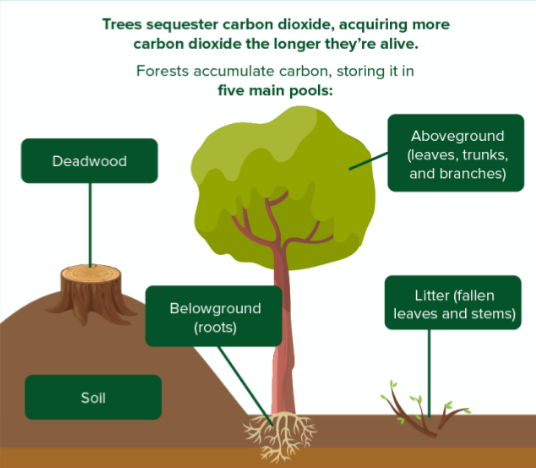
SOIL
CO2 can be removed from the atmosphere and stored in the soil carbon pool. This storage process is carried out by plants through photosynthesis, with carbon stored in the form of soil organic matter (SOC) or organic compounds. These compounds are then incorporated into the soil through plant residues and root exudates.
Bogs, peat and swamps can capture and store CO2 as carbonates. These carbonates (containing store CO2) which has build up thousands of years ago mixes with other mineral elements, such as calcium or magnesium minerals.
OCEANS
Aquatic environments and large bodies of WATER like oceans are great absorbers of CO2 from the atmosphere. The carbon are usually held in the upper layers of the oceans. High amount of this carbon can cause water acidity. This can negatively affect the water biodiversity that exists below the aquatic environment. For example,
Ocean habitats like mangrove can sequester carbon dioxide from the atmosphere at rates up to four times higher than terrestrial forests. Their ability to capture and store carbon make mangroves highly valuable in the fight against climate change. Thus, Mangroves are some of the most carbon-rich ecosystems on the planet.
2. GEOLOGICAL CARBON SEQUESTRATION
Geological carbon sequestration is also called carbon storage. It involves storing CO2 deep underground in geological formations or porous rocks. In the rock, CO2 is compressed and pressurized into a liquid form. It then flows into porous areas in the underground rock where it becomes trapped within the pore spaces in the rock. It dissolves in the fluid in the pore spaces, and eventually reacts with minerals to form stable minerals.
CaSiO3( wollastonite) + CO2 + 2H2O =
CaCO3 + H4SiO4
Mg2SiO4 (olivine) + 2CO2 + 2H2O = 2MgCO3 + H4SiO4
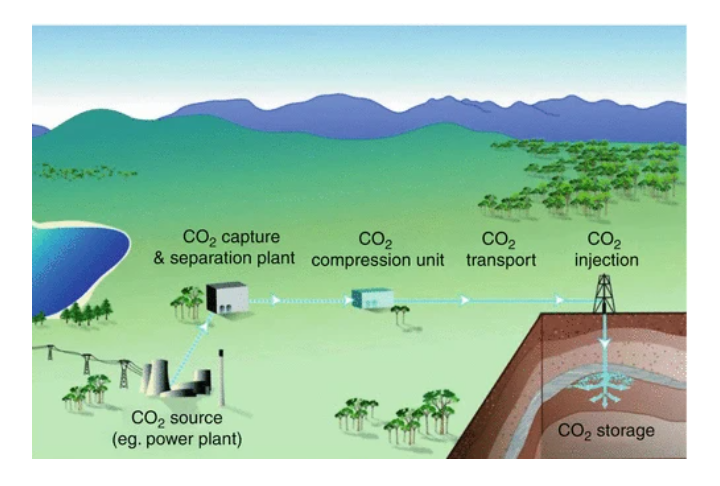
3. TECHNOLOGICAL CARBON SEQUESTRATION
The technological carbon sequestration are new innovations developed by scientists to remove and store carbon from the atmosphere and also utilize the carbon in other ways. The technologies developed for carbon sequestration include:
a. GRAPHENE PRODUCTION
Graphene is a material that is extracted from graphite and is made up of pure carbon. It requires CO2 as a raw material. it is found in objects like the lead of a pencil, manufacturing batteries, cement, and light bulbs etc. It is also used heavily in the production of the technology devices (flexible screens) such as smartphones or computer processors . Graphene stands out for being tough, flexible, light, and with a high resistance.
b. DIRECT AIR CAPTURE (DAC): This is a technology that removes carbon dioxide (CO2) from the atmosphere . During DAC, high-powered fans is used to draw air into a processing facility where CO2 is separated through a series of chemical reactions. The CO2 is either permanently stored in underground reservoirs through secure geologic sequestration, or is used to make new products such as building materials and low-carbon fuels. This process is energy intensive and expensive, for removing carbon on a mass scale.
c. ENGINEERED MOLECULES
Scientists develop engineering molecules that can change shape when they capture CO2 from air and form a new kinds of compounds. The engineered molecules act as a filter, only attracting the element it was engineered to seek
d. CARBON CAPTURE AND STORAGE (CCS)
This involves capturing CO2 produced by power generation or industrial activity, such as cement or steel making.
For example, In construction industry, carbon dioxide (CO2) emission is a serious concern. Carbon sequestration in cementitious materials is a solutions to the problem of this emission. When concretes are produced and used for constructions, carbon dioxide are captured naturally in a process called carbonates. The absorption of CO2 turns the built environment into carbon sinks. This promote CO2 sequestration in cementitious materials.
THE CARBON CYCLE
Carbon sequestration is just a part OF carbon cycle. It is a nature’s way of reusing carbon.
The cycle is a way through which carbon dioxide is released into the atmosphere and absorbed back into Earth. Carbon is stored and released through photosynthesis, decomposition, combustion, and respiration.
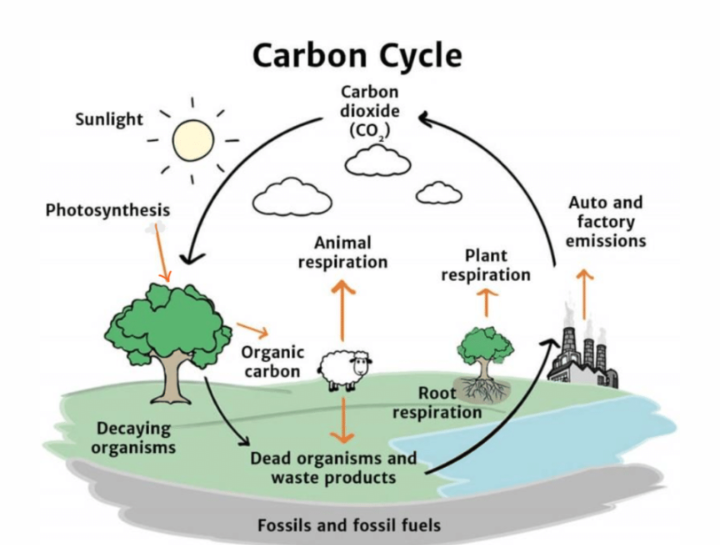
Carbon can be stored in rocks and sediments, in the ocean, and in living organisms. The Carbon is released back into the atmosphere when living organisms die, volcanoes erupt, or when fossil fuels are burned.
CO2 is absorbed by plants through the process called photosynthesis . It also sink into the Ocean from the atmosphere. This create a balance between the carbon emitted and absorbed in nature.
HOW SOIL CARBON IS INCREASED
Agricultural fields can act as a carbon store through sequesteration of carbon, binding of carbon to soil colloids and greenhouse gasses.
Soil carbon can be increased in various ways, including:
(1) Reducing soil disturbance by switching to low-till or no-till practices or planting perennial crops that stay a longer time on the field.
When soil is disturbed by ploughing or tilling a field, carbon dioxide stored in the soil is released back into the atmosphere. When fields is not tilled, carbon stays stored in the ground. This is a way through which agriculture can address climate change
(2) Changing planting schedules or rotations, such as by planting cover crops or double crops instead of leaving fields fallow. Rotation can increase soil organic carbon stocks (SOC) by improving root and aboveground biomass. Thus, providing a relatively more abundant carbon source for the soil
(3) Managed grazing of livestock. Grazing animals eat most of the aboveground biomass and produce manures. In the manures are carbon which eventually return to the soil as the manure decompose or to the atmosphere through enteric fermentation.
(4) Applying compost or crop residues to fields. The carbon in these materials are released into the soil during decomposition. The crop residues and roots will decompose and the carbon in them will be stored in the soil organic matter
Atmospheric carbon can be increased by
1. Human activities which causes about 48% increase of the concentration of CO2 in the earth’s atmosphere. Such activities include burning fossil fuels etc.
2. RESPIRATION IN ANIMALS . Animals and man breathe in oxygen and releases CO2 in return
3. DEFORESTATION :. Reducing the amount of forest cover which ought to utilise the atmospheric carbon create a major problem as more CO2 are left unused in the atmosphere.
4. livestock farming. 5. The rapid expansion of farming, development, and industrial activities also cause an increase in atmospheric CO2
FACTORS THAT AFFECT CARBON SEQUESTRATION
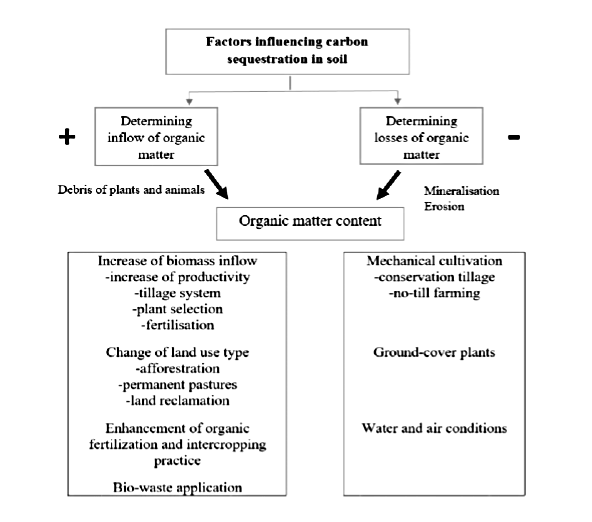
1. Deforestation poses the biggest threat to carbon sequestration process.
2. Construction also affect carbon sequestration process
3. Intensive agriculture also determines storage of carbon in the soil
4. Tillage operations lowers that amount of carbon store in the soil
5. Climate change may alter temperature and moisture regimes that could influence decomposition rates and stability of SOC
6. Ecological forces which are unplanned events such as hurricanes and droughts.
BENEFITS OF CARBON SEQUESTRATION
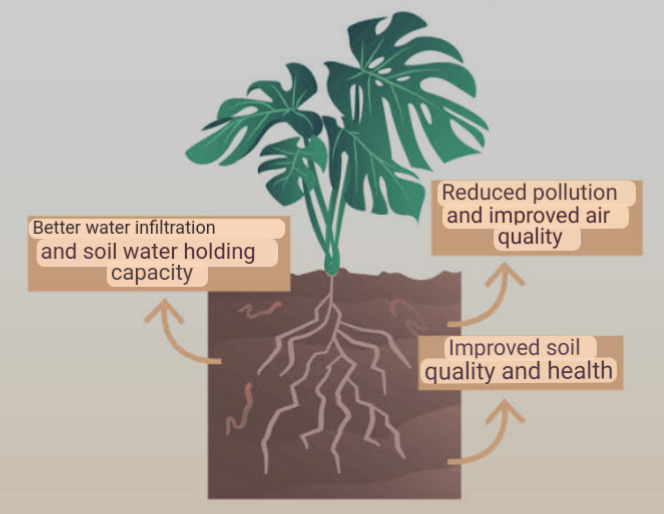
1. IMPROVE SOIL HEALTH : Soil carbon sequestration helps restore degraded soils, which can improve agricultural productivity. Many of the soil amendments improve soil health, and also sequester carbon. Amendments that increase soil organic matter may improve the water holding capacity, add nutrients to the soil and improve soil structure etc
2. INCREASED CLIMATE RESILIENCE : Healthier soils make farms more resilient against erosion, runoff, droughts and heavy rainfall.
3. REDUCED FERTILIZER USE : Soil ammendments improves soil health. Such healthy soil require less fertilizer. Thus, reduce amount invested on farm and reducing environmental pollution.
4. DIFFICULTY OF MEASUREMENT : Monitoring and quantifying carbon removal through soil carbon sequestration is difficult and costly.
5. IMPROVE SOIL FERTILITY: Carbon supply is usually related to the build-up of soil fertility, which in turn allows for a reduction of external inputs, such as synthetic fertilizers and pesticides.
6. The longer the length of years of a forest, the more the carbon it will sequester. Carbon accumulates in forest soil, living trees and forest floor.
7. PURIFICATION OF AIR: Plants take in carbon dioxide which can cause climate change to produce oxygen which is beneficial to human and animals.
8. SOLUTION TO CLIMATE CHANGE AND GLOBAL WARMING : Negative effect of climate change include increase in atmospheric temperature, wildfires and flooding, etc. It reduces greenhouse gas emissions and can be used to store carbon dioxide that is already in the atmosphere. Carbon sequestration reduces these effects, prevent runoff and also reduce erosion as plants play the major role.
9. HEALTH BENEFITS : Reduction of atmospheric CO2 have positive impacts on public health and well-being. High amount of atmospheric CO2 result in poor human health. For example, causes headaches, dizziness, difficulty breathing and increased heart rates. Studies have also proven that long exposure to high CO2 causes diabetes, respiratory diseases, and neurological disorders
10. CREATE JOB OPPORTUNITIES: Such job include conservationist, Agriculturist and researchers etc.
DISADVANTAGES OF CARBON SEQUESTRATION
1. It can acidify the water, posing a threat to the biodiversity that exists below – yet another reason to decarbonise our atmosphere.
2. It is expensive to implement. large amount of money is required to be invested in technology, infrastructure and research on carbon sequestration.
3. Continuous activities of industries causes pollution and environmental damage. But policies are now put in place to mitigate against companies releasing gases containing carbon into the environment.
MANAGEMENT OF CARBON
These best management practices include afforestation, reduced or no-till, crop rotation, cover crops, converted or improved pasture, organic amendments and residue retention, that have the potential to sequester carbon
